Notes: Manchester Exchange was situated on the London & North Western Railway’s (LNWR) east and west route that connected Liverpool with Leeds. The first section of the route was the historic Liverpool & Manchester Railway (L&MR) which had opened in September 1830. At the time of opening the L&MR had its eastern terminus at Manchester Liverpool Road station but by the 1840s traffic had increased to such a degree that a new station was needed. The initial solution was to build a new section of line, the Hunts Bank Extension, to connect with the Manchester & Leeds Railway (MLR) at their Victoria station. The MLR had agreed to allow the L&MR to use platforms at Victoria.
Manchester Liverpool Road station closed on 4 May 1844, and from that date passenger services were extended to Victoria.
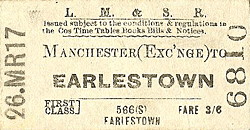 |
On 8 August 1845 the L&MR was absorbed into the Grand Junction Railway. A year later, on 16 July 1846, that company, along with a number of others, merged to form the LNWR. On 8 July 1847 the MLR became the Lancashire & Yorkshire Railway (LYR).
Amongst the companies that merged to form the |
LNWR was the Huddersfield & Manchester Railway which had begun a trans-Pennine route via Standedge; this would form an alternative to the MLR to Leeds, albeit with the LNWR having to exercise running powers over lines owned by the LYR. When the Huddersfield line opened to goods services in 1850 the LNWR had created its east-to-west trans-Pennine route although, over the following decades, additional lines and connections were created to improve it.
It was no surprise that the LYR gave priority to its own services at Manchester Victoria and, even though the station was expanded over the years, by the 1880s it was seriously congested and the LNWR was constantly frustrated. The solution was for the LNWR to seek powers to build its own station.
Manchester Exchange station opened partially on 30 June 1884 and fully in July 1885. It was actually located in the city of Salford but only a stone’s throw away from central Manchester from which it was separated by the River Irwell. It lay immediately west of the LYR Manchester Victoria station which was on the other side of the Irwell and therefore within Manchester. Exchange station was elevated above street level being carried on brick arches. It was reached by an approach road from Victoria Street which spanned the River Irwell. Its main entrance was south of the line and consisted of a grand four-storey stone building flanked by other smaller structures. Within the main building were offices and refreshment rooms; cloak rooms, toilets and further offices were in the other buildings.
To the east of the imposing frontage building was an access point for road vehicles. The station was provided with a trainshed roof of three arched sections which extended for almost the entire length of the platforms.
The station had five platforms, two of which were |
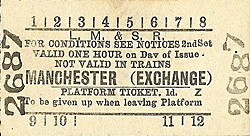 |
terminus platforms and three had through lines. The terminus platforms were numbered 1 and 2 and they led out to the west. They were located on the southern side of the site directly beyond the entrance. Adjacent to platform 2, and to the north of it, was platform 3 which was longer than the two terminus platforms. Immediately east of the buffer stops, at the end of the terminus platforms, was the booking office.
Platforms 4 and 5 were on a long and wide island platform. A footbridge linked it to the terminus platforms and platform 3, but it also had a cab road that tunnelled under the line at the eastern end of the station and reached the platform by a sloping roadway. At the eastern end of the island platform, adjacent to the footbridge, were a parcels office and a ladies’ waiting room.
The LYR main line between Bolton and Leeds passed by the north of Exchange station. At its western end, south of the line, were a turntable and stabling sidings for locomotives.
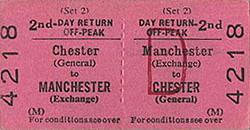 |
At the time of opening Manchester Exchange would have been served by trains between Liverpool and Manchester, trans-Pennine services via the LNWR route to Leeds, services running to and from North Wales, and services to London and to Scotland. There were also local trains to such destinations as Wigan and Bolton. The LNWR reached an agreement with the |
Great Western Railway (GWR) which allowed that company to run services into Manchester Exchange thereby giving the GWR its only access to the city of Manchester. GWR express services reached Exchange via the joint LNWR/GWR line which connected Chester with Warrington; from Warrington they ran over LNWR metals to Exchange.
During the latter part of the nineteenth century and into the early part of the twentieth the competition to attract passengers between Liverpool and Manchester was intense. Passengers had four choices: the Cheshire Lines Committee (CLC) between Manchester Central and Liverpool Central; the LYR between Manchester Victoria and Liverpool Exchange; and the LNWR between Manchester Exchange and Liverpool Lime Street and between Manchester London Road and Liverpool Lime Street via Warrington Bank Quay. The first three were the fastest and it was over these that each company introduced hourly express services which completed the journey in just over 40 minutes. The LNWR route from Exchange to Lime Street was the shortest but it faced very stiff competition from the CLC who had a very straight and fast line.
The December 1895 Bradshaw timetable listed main line departures from Manchester Exchange to Birmingham, Chester, Glasgow, Holyhead, Huddersfield, Leeds, Liverpool and London. Numerous local services operated including the weekday morning services shown in the table below.
| Local Departures from Manchester Exchange December 1895 |
| Departure |
Destination |
05.25am |
Patricroft |
05.55am Mondays Only |
Stanley |
06.00am |
Wigan North Western |
06.45am |
Bolton Great Moor Street |
07.00am |
Warrington Bank Quay |
07.20am |
Wigan North Western |
07.45am |
Patricroft |
08.00am |
Bolton Great Moor Street |
08.05am |
Warrington Bank Quay |
08.15am |
Blackpool |
08.30am |
Liverpool Lime Street |
08.50am |
Patricroft |
09.00am |
Liverpool Lime Street |
09.05am |
Wigan North Western |
09.30am |
Tyldesley |
09.40am |
Warrington Bank Quay |
10.00am |
Blackpool |
10.10am |
Patricroft |
10.25am |
Tyldesley |
10.30am |
Bolton Great Moor Street |
11.05am |
Wigan North Western |
On 1 January 1922 the LYR was absored into the LNWR and a year later the LNWR became part of the London Midland & Scottish Railway. In 1929 the LMS combined platform 3 at Manchester Exchange with platform 11 at Manchester Victoria to make a continuous platform of 2235 ft: this was the longest platform in Europe. Its benefit was to offer the LMS operational flexibility so that it could route the most appropriate trains into the more appropriate station. The GWR continued to operate services to Manchester Exchange.
The LMS summer timetable for 1932 showed the following afternoon weekday departures from Manchester Exchange.
| Afternoon Departures from Manchester Exchange Summer 1932 |
| Departure |
Destination |
Departure |
Destination |
12.05pm |
Llandudno |
2.40pm Saturdays excepted |
Patricroft |
12.07pm |
Bolton Great Moor Street |
2.25pm |
Chester General |
12.18pm Saturdays only |
Kenyon Junction |
2.20pm |
Liverpool Lime Street |
12.20pm Saturdays only |
Leigh |
2.44pm |
Liverpool Lime Street |
12.30pm Saturdays only |
Glasgow |
2.45pm Saturdays only |
Llandudno |
12.32pm |
Patricroft |
3.00pm |
Liverpool Lime Street |
12.35pm Saturdays excepted |
Liverpool Lime Street |
3.07pm |
Newcastle upon Tyne |
12.37pm Saturdays only |
Liverpool Lime Street |
3.10pm |
Earlestown |
12.45pm Saturdays excepted |
Leigh |
3.15pm |
Huddersfield |
12.48pm Saturdays only |
Leigh |
3.20pm |
Bolton Great Moor Street |
12.50pm |
Leeds |
3.28pm |
Batley |
12.55pm Saturdays only |
Llandudno |
3.35pm |
Wigan North Western |
1.00pm Saturdays excepted |
Liverpool Lime Street |
3.38pm |
Warrington Bank Quay |
1.05pm Saturdays excepted |
Kenyon Junction |
3.40pm |
Chester General |
1.08pm |
Liverpool Exchange |
3.45pm |
Blackpool Central |
1.10pm Saturdays only |
Wigan North Western |
3.50pm |
Leeds |
1.15pm Saturdays only |
Kenyon Junction |
4.10pm |
Windermere/Barrow |
1.25pm Saturdays only |
Wigan North Western |
4.10pm |
Huddersfield |
1.30pm |
Patricroft |
4.12pm |
Wigan North Western |
1.40pm |
Llandudno |
4.25pm |
Bolton Great Moor Street |
1.50pm Saturdays excepted |
Bolton Great Moor Street |
4.25pm Saturdays only |
Llandudno |
1.52pm |
Leeds |
4.30pm Saturdays excepted |
Llandudno |
1.55pm Saturdays only |
Holyhead |
4.42pm Saturdays excepted |
Leigh |
1.57pm Saturdays only |
Patricroft |
4.47pm |
Hull |
2.00pm Saturdays excepted |
Liverpool Lime Street |
4.48pm |
Liverpool Lime Street |
2.15pm Saturdays only |
North Wales Express |
4.55pm |
Liverpool Lime Street |
In December 1940 Manchester Exchange was badly damaged by enemy bombing. The station building was almost completely destroyed, and what was left had to be demolished; it was later replaced with an ugly brick wall frontage. The station was patched up and brought back into use.
| On 1 January 1948 Manchester Exchange became part of British Railways (London Midland Region). In the late 1950s many of the local services from Exchange went over to DMU operation. In 1960 British Railways introduced new six-coach trans-Pennine DMUs onto the Liverpool and Hull service which was branded as the Trans-Pennine service. The stylish DMUs brought |
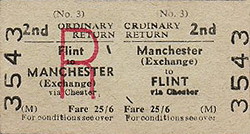 |
a new standard of comfort and accelerated timings to the route and proved popular with passengers. The summer 1962 timetable showed seven Trans-Pennine services from Manchester Exchange to Hull and five to Leeds City, all of them having started from Liverpool Lime Street. Eleven of these services ran from Manchester Exchange to Liverpool Lime Street. There were, in addition, many other east - west services such as the Liverpool and Newcastle expresses. Services between North Wales, Chester and Manchester continued to use Exchange as did local trains running between Liverpool and Manchester, either along the original L&MR or via Leigh.
The Reshaping of British Railways (‘Beeching’) report, whilst recommending the withdrawal of passenger services from a number of routes in north-west England, did not propose the closure of any of Manchester’s four termini. However the withdrawal of numerous passenger services in the mid 1960s reduced the congestion at Manchester Victoria, and British Railways felt that economies could be exercised by transferring passenger services from Exchange to the adjacent Victoria station. Consequently on 30 May 1968 the proposal to close Exchange station was published, and the Minister of Transport gave consent on 27 November 1968. (Considering that the stations shared one platform, BR could possibly have saved the expense of an enquiry into closure by officially combining Victoria and Exchange stations as ‘Victoria’, then closing the former Exchange platforms!)
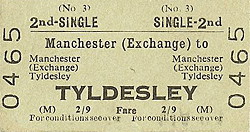 |
On 5 May 1969 the remaining services at Manchester Exchange were diverted to Manchester Victoria, and the station closed to passengers. (On the same date Manchester Central also closed.) Track was lifted from platforms 1 and 2 and they were filled in, the space being given over to car parking. The lines through platforms 3, 4 and 5 remained in situ, and |
trains continued to pass through the station. In the early 1980s the trainshed roof was demolished, and in 1993, when Manchester Victoria was substantially altered and all the lines leading to it rationalised, the tracks through Exchange were lifted.
In 2012 platforms 3, 4 and 5 still survived as did the station footbridge. It continued to be used as a public car park. In 2015 demolition of the station foundations began.
Tickets from Michael Stewart and Bradshaw from Nick Catford.
Sources:
To see the other closed stations on the Liverpool & Manchester Railway click on the station name: Liverpool Crown Street, Huyton Quarry, Lea Green, Collins Green, Parkside 1st, Parkside 2nd, Kenyon Junction, Glazebury and Bury Lane, Flow Moss, Astley, Lambs Cottage, Barton Moss 1st, Barton Moss 2nd, Weaste, Seedley, Cross Lane, Ordsall Lane & Manchester Liverpool Road
|

old11.jpg)
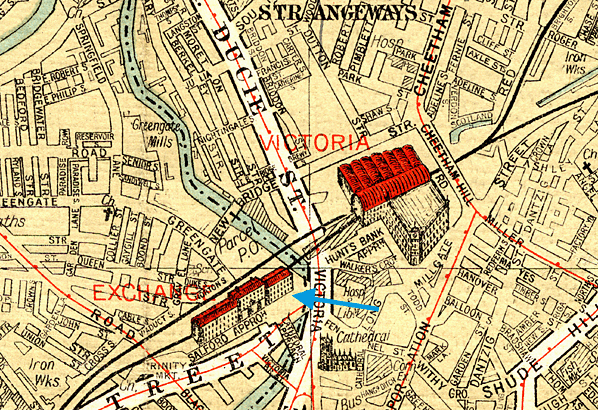
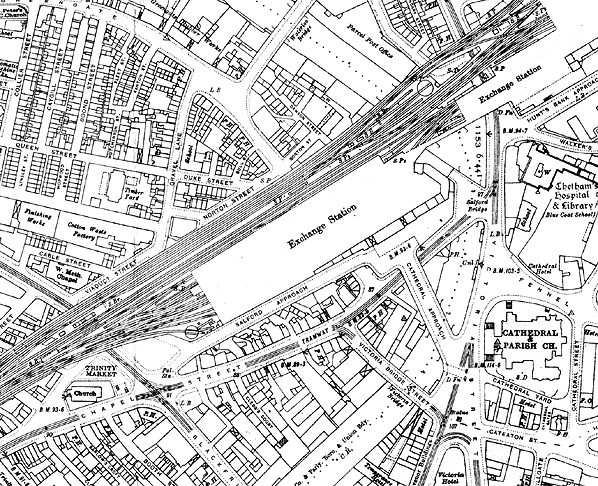
exchange_old11.jpg)
exchange_old14.jpg)
exchange_old13.jpg)
old14.jpg)
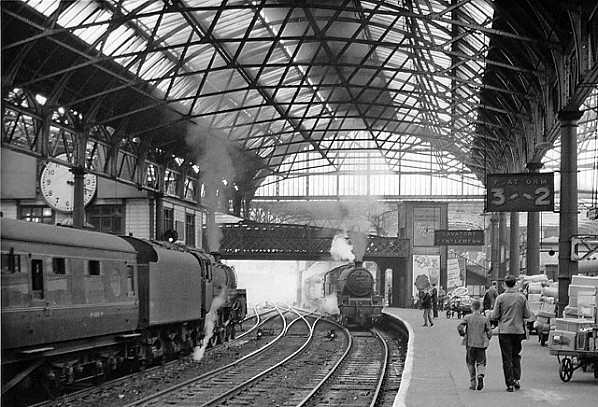
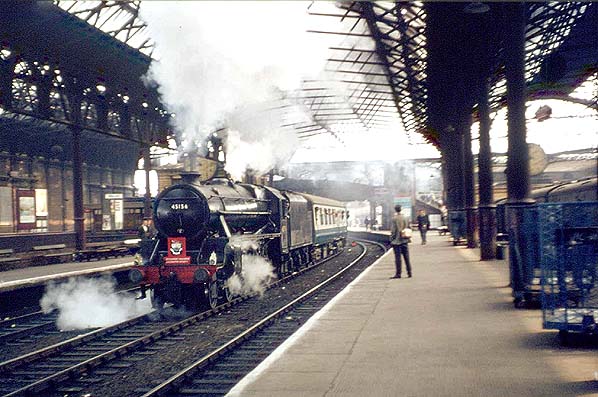
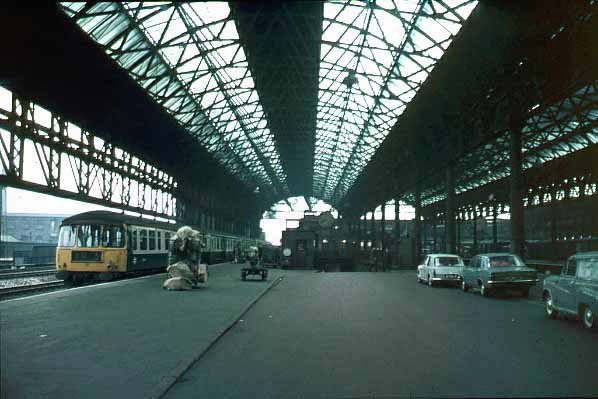
.jpg)



.jpg)


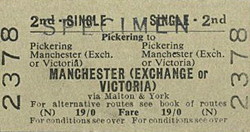
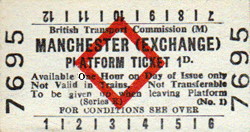

 Home Page
Home Page